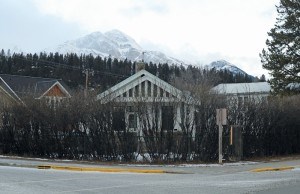
Despite significant opposition, Parks Canada has—for the second time—given conditional approval to the rezoning of two lots on Connaught Drive for the development of an apartment building.
Rob Olson, who owns the lots adjacent to the Crimson Jasper, originally received conditional approval in October 2014, but after an outpouring of opposition letters and some procedural issues, the Planning and Development Advisory Committee held a second hearing Dec. 18.
That hearing saw more than a dozen residents pack into the Grand Trunk Pacific Boardroom to express their opposition to Olson’s request to rezone 120 and 122 Connaught Dr. to R3b (multi-unit dwelling)—the lots are currently zoned R2 (two-unit dwelling).
Olson received conditional approval Jan. 6. The conditions include a restriction on the maximum height of the building, reducing it to 10 metres from 13.7 metres, and a requirement that the building design conform to all R3b zoning requirements—with no variances being considered.
Following the decision, Olson said he is “definitely relieved.”
“I don’t know what we would do if it wasn’t approved,” he said, referring to himself and his sister, who is an equal partner in the development.
The pair are proposing the contruction of a 10-unit apartment building with two-bedroom, two-bathroom suites.
“We’re going to build a place that’s for permanent residents and families,” explained Olson.
“Hopefully some other people will follow and do something similar—we could use 10 of [these developments] in town.”
Parks Canada didn’t respond by press time to discuss whether or not appeals will be heard on the decision, in light of the fact that two hearings have already been held.
But, if the second hearing is to follow the same rules as the first, the public will have an opportunity to appeal Parks’ decision. According to a Parks document, in order to appeal, a person has to “demonstrate that either the relevant development requirements were misrepresented, that not all the relevant information was before the committee when they formulated their decision or that the development review process was not followed.”
After an appeal hearing there are no further opportunities to appeal the decision, except through legal recourse.
If—because there have already been two hearings—there is no appeal process, or if there is one and no one petitions Parks’ decision, Olson said he hopes to break ground in the summer and have the building completed by Spring 2016.
Residents in the neighbourhood cited numerous reasons for their opposition to the rezoning of the lots. Some of those concerns include the loss of views and sunlight, increasing density in an already busy neighbourhood, parking issues, the precedent of allowing spot zoning and a disinterest in having rental units next door.
Six residents spoke out in opposition at the Dec. 18 hearing and five others gave proxy, allowing others to speak on their behalf.
The presentations varied, some pointed out the problems with the PDAC process, others pointed out the incongruencies in Olson’s presentation from the September hearing, and others pulled apart Parks’ conditional approval—pointing to statements in the Jasper Community Sustainability Plan as reasons why the request should have been rejected.
Residents made similar arguments at the first hearing, but despite that the committee recommended that rezoning move forward and Parks took its advice, providing conditional approval.
That approval came from Jeff Anderson, vice president of operations for Western and Northern Canda. In a letter he wrote, “Changing demographics and visitation patterns produce both challenges and opportunities that require flexibility and re-examination of what the best guidelines or zoning might be.
“It was felt that the impacts on the neighbourhood in terms of both density and parking would not be significantly different with either R2 or R3b development.”
Nicole Veerman
[email protected]
